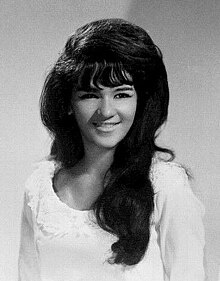Nedra Talley
Nedra Talley | |
|---|---|
 Talley in 1966 | |
| Background information | |
| Birth name | Nedra Talley |
| Also known as | Nedra Talley-Ross |
| Born | January 27, 1946 New York City, U.S. |
| Genres | |
| Occupation | Singer |
| Years active | 1957–2005 |
| Labels | |
| Formerly of | The Ronettes |
| Spouse |
Scott Ross
(m. 1967; died 2023) |
Nedra Talley (born January 27, 1946),[1] now known as Nedra Talley-Ross, is a retired American singer. She is best known as a former member of the girl group the Ronettes, in which she performed with her cousins Ronnie and Estelle Bennett.[2] Since Ronnie's death in 2022, Talley is the last surviving original member of the group.
Career
[edit]In 1967, Talley and Estelle Bennett left the Ronettes, a decade after the group's formation. The split was reportedly due in part to interference from the group's producer Phil Spector, who later married Ronnie Bennett.[3] Talley said that when she met Scott Ross, her future husband, she became a born-again Christian. Talley also decided to leave the Ronettes because she felt there was little place for Christian-inspired music.[4]
In 1977, Talley recorded several Christian songs written by her church's music director, Ted Sandquist. These were released on the album The Courts of the King: The Worship Music of Ted Sandquist. One of the cuts, a medley, "Love of My Lord" / "Redwood Tree" was released as a 45 promo single. Guitarist Phil Keaggy played on at least two of the album cuts with her. For its 30th anniversary, this album was finally released on CD.[citation needed]
In 1978, Talley recorded Full Circle, a solo contemporary Christian music album, on which Keaggy once again musically backed her. Keaggy wrote the title track and released his own version of it on his 1981 album Town To Town.[5] The album was produced by Talley's husband, Ross. The album's inner sleeve featured Talley's bio (and salvation story), but also a photo taken in the mid-'60s aboard a plane with Talley and fellow Ronette, Estelle Bennett, sharing seats with The Beatles' John Lennon and George Harrison, who were great fans of the Ronettes. The album has to date, never been re-released.[citation needed]
A four-disc set, Roger McGuinn's The Folk Den Project (1995–2005), featured the old folk song, "Follow the Drinking Gourd", as sung by McGuinn with Talley providing the sole but prominent background vocal.[citation needed]
In 2007, the Ronettes were inducted into the Rock and Roll Hall of Fame.[3]
Personal life
[edit]Talley is of black, Native American, Irish, and Puerto Rican descent.[6] Her husband was Scott Ross (1939–2023), a former DJ[3] turned interviewer for The 700 Club on the Christian Broadcasting Network.[7] They have four children. As of 2007, she was a businesswoman working in real estate. She lives in Virginia Beach, Virginia.[8]
See also
[edit]References
[edit]- ^ "The Ronettes Biography". Archived from the original on July 1, 2018. Retrieved July 17, 2013. Note: Talley's birth year was open to speculation. This entry states 1946. Several other sources cited 1944. However a search of Virginia legal records (via Intelius) shows conclusively her birthdate as being January 27, 1946
- ^ "Estelle Bennett: Ronettes singer, 67". Philadelphia Inquirer. February 14, 2009. Retrieved January 22, 2021.
- ^ a b c "Forever and a song". The Hartford Courant. March 11, 2007. Archived from the original on June 12, 2011. Retrieved September 18, 2009.
- ^ "A Ronette Encounters a Big God". cbn.com. Archived from the original on September 23, 2015. Retrieved October 18, 2015.
- ^ "Nedra Ross Biography". Archived from the original on June 10, 2011. Retrieved September 18, 2009.
- ^ Sisario, Ben (February 16, 2009). "A Life of Troubles Followed a Singer's Burst of Fame". The New York Times. Archived from the original on December 19, 2012. Retrieved May 20, 2010.
- ^ "CBN Family Mourns Passing of Scott Ross: A Lifelong Christian Broadcaster". August 14, 2023.
- ^ "Forever and a song". Daily Press. March 11, 2007. Archived from the original on January 9, 2016. Retrieved October 18, 2015.
- 1946 births
- Living people
- 20th-century American singers
- 21st-century American singers
- 20th-century African-American women singers
- Singers from New York City
- American musicians of Puerto Rican descent
- The Ronettes members
- Native American singers
- 20th-century American women singers
- 21st-century American women singers
- 21st-century African-American women singers
